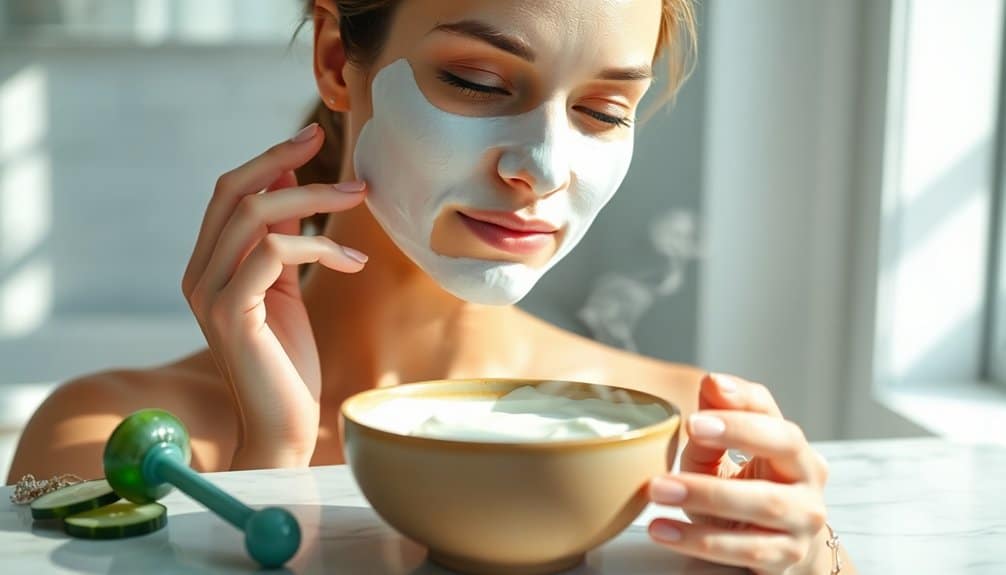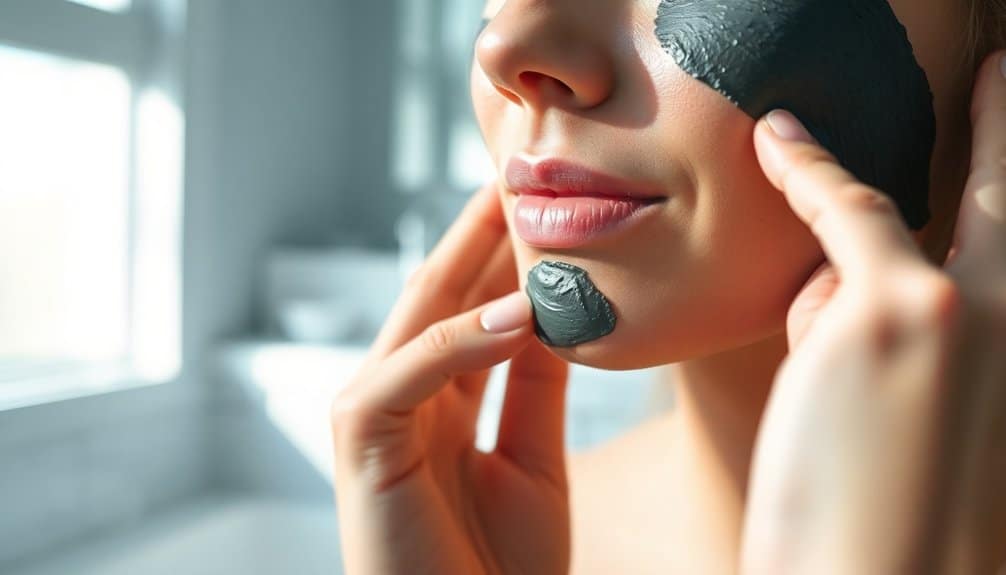Your cleansing balm holds a wealth of potential beyond mere makeup removal.
These rich, creamy formulations can serve as both daily cleansers and restorative face masks. When applied as a cleanser, they gently dissolve even the most stubborn makeup, while ensuring your skin retains its softness.
As a mask, these balms go deeper, offering an infusion of moisture that can illuminate your complexion beautifully.
It’s essential to choose the method that aligns with your skin’s needs and the experience you seek.
For example, if your skin craves hydration, consider applying the balm as a mask occasionally.
Alternatively, for daily cleansing, let it melt away impurities and makeup, granting you that delicate softness you desire.
Embrace the versatility of your cleansing balm, and discover which approach best nurtures your unique skin.
Table of Contents
Toggle
Caring for your skin requires thoughtful choices, especially when balancing the variety of products available. Your routine doesn’t have to be rigid, and embracing multifunctional products can be a wonderful way to address your skin’s unique needs each day.
Cleansing balms are particularly beneficial in this regard. These balms effectively clean the skin, effortlessly removing makeup and impurities without disturbing the delicate natural barrier. Their creamy, oil-based formula is excellent for dissolving even the most stubborn products, such as waterproof mascara, with gentle motions. This ensures your skin maintains its softness and hydration instead of feeling tight or irritated.
Interestingly, the same cleansing balm can also transform into a nourishing mask. By applying it to clean skin and allowing it to sit for around ten minutes, the enriching ingredients can penetrate deeper layers—inviting moisture from ceramides and hyaluronic acid to work diligently. The result is often a plumper, more radiant complexion.
This flexibility allows for a personalized approach to skincare. If time is short in the morning, the cleansing balm serves well for a quick cleanse. Yet, on a slower day, it can offer the indulgence of a hydrating mask while you take a moment for yourself. It’s about responding to your skin’s needs in the moment.
For those with oily or acne-prone skin, traditional face washes maintain a valuable role. The light foaming action effectively reaches deep into pores, eliminating excess oil and helping prevent breakouts. Still, these can sometimes lead to dryness or irritation if not carefully selected.
Face masks, each offering targeted treatment for specific conditions, provide another layer of possibility in skincare routines. Clay masks are great for detoxifying, while sheet masks provide hydration and gel masks ease inflammation. The longer application time allows for active ingredients to work their magic more effectively than quick cleansing might allow. Double cleansing with a gentle cleanser first followed by a face wash can be particularly effective for removing SPF, makeup, and pollutants while ensuring complete purification.
Cleansing balms often include antioxidants and brightening agents such as vitamin C and rosehip oil. Regular application as a mask can gradually improve your skin’s tone and texture. Furthermore, since most balms are non-comedogenic, they won’t clog pores, even with extended wear.
The allure of dual-purpose products lies in their practicality and efficiency. By investing in one item, you gain multiple benefits, which simplifies your skincare lineup. Whether addressing dryness, sensitivity, or just aiming for a healthy glow, having diverse options allows your routine to adapt as your skin evolves. Your skin is ever-changing, and your approach to caring for it can be just as dynamic.
Applying face cleansers twice daily is fundamental to a solid skincare routine. Morning and evening cleansings help to erase impurities and prepare the skin for any subsequent treatments. Introducing face masks into your regimen can elevate your skincare routine—1 to 3 times weekly is typical. The type of mask you choose matters greatly; for instance, clay masks are more suitable for those with oily skin and can be used with greater frequency, while those with sensitive skin may prefer hydrating masks, using them less often. Always be attentive to your skin’s reactions so you can adjust usage accordingly, avoiding any potential irritation.
Regarding face masks, using them every day can be appropriate depending on the formulation and your skin type. Gentle, hydrating masks can indeed be used daily for those with dry skin. In contrast, masks that contain clay or exfoliating ingredients should limit their use to 2–3 times a week. While overnight masks offer extended benefits, they should also not be applied daily. Following product recommendations and remaining observant of your skin’s responses will guide you.
Before applying a face mask, cleansing is a key step. This process removes surface dirt and prepares your skin for maximum absorption. By using your usual cleanser first and then applying the mask to clean, slightly damp skin, you enhance the efficacy of the mask’s ingredients, ensuring they work their best.
As for the timing, evening is often the most beneficial time to indulge in face masks. This allows the skin to repair itself during sleep, away from environmental irritants. Masks can apply productively during your nighttime routine, letting active ingredients take effect without competition from makeup or UV rays. Morning use can suit hydrating formulas, but vigilance is necessary to avoid ingredients that may heighten sensitivity to sunlight; always follow with a dedicated sunscreen.
The duration for leaving a mask on varies greatly by type. Clay masks typically need to be removed after about 10 to 15 minutes, once fully dry, to avoid drying out the skin. Hydrating masks can usually stay on for 15 to 20 minutes, although instructions may vary, especially for overnight masks designed to be worn while you sleep. In all instances, should any irritation arise, promptly remove the mask.
Mixing different masks is generally inadvisable, as this can disrupt the effectiveness of the ingredients and may lead to irritation. Instead, consider alternating masks throughout the week or targeting specific areas of your face based on your skin’s needs. For combination skin, a purifying mask on the T-zone alongside a hydrating mask on drier areas may strike a harmonious balance.
Once you’ve removed your face mask, gently pat your skin dry with a clean towel. This allows you to maintain skin integrity. It’s beneficial to follow with a hydrating serum or moisturizer to seal in the moisture and nutrients just delivered. Avoid sun exposure immediately after using exfoliating or brightening masks, always incorporating a good sunscreen into your daytime routine.
When it comes to choosing between a cleanser and a mask, consider your skincare goals. Cleansers serve as essential daily products for initial purification and skin preparation. Masks provide deeper, more focused treatments for specific issues, such as cleansing, hydration, or brightening. If time constraints are a concern, dual-purpose cleansers that also function as masks can offer an effective solution, allowing you to enjoy the best of both worlds. Multi-action cleansers combine the convenience of daily cleansing with the intensive benefits of a purifying mask treatment.
For those with sensitive skin, carefully chosen masks can be beneficial. Look for gentle formulations enriched with calming botanicals and steer clear of harsh chemicals or fragrances. Always patch test a new product before full application, starting with shorter durations to gauge your skin’s tolerance. Generally, hydrating or calming masks will complement sensitive skin better than clay or exfoliating masks.
After using either a cleanser or a mask, moisturizing is a crucial step in safeguarding your skin. Even products hailed as hydrating would benefit from a follow-up moisturizer, which helps to reinforce the skin’s barrier. Opt for lighter formulas for oily skin and richer creams for those experiencing dryness. This practice not only enhances the absorption of subsequent skincare products but also maintains a harmonious balance for healthy skin.

Mastering the application of face masks can elevate your skincare ritual. It requires neither lavish tools nor costly products; instead, effective techniques can bring out your skin’s best qualities.
First, consider your face a canvas that requires careful preparation. Begin with a thorough cleansing to rid your skin of impurities. A gentle exfoliation follows, ensuring nothing interferes with the absorption of beneficial ingredients.
When applying the mask, do so mindfully. Use thin, even layers and steer clear of the sensitive eye region for safety reasons. This thoughtful approach maximizes the mask’s effectiveness without risking irritation.
Timing is essential. Adhere to the instructions provided with the product; most masks need around 15 to 20 minutes. This precision allows the ingredients to deliver their benefits optimally. Leaving masks on longer than recommended can lead to skin dryness, so proper timing is crucial for maintaining healthy skin.
Before trying any new product, always conduct a patch test. Each person’s skin is unique, and what may work for one may not suit another. Trust your intuition and modify your routine as your skin requires.